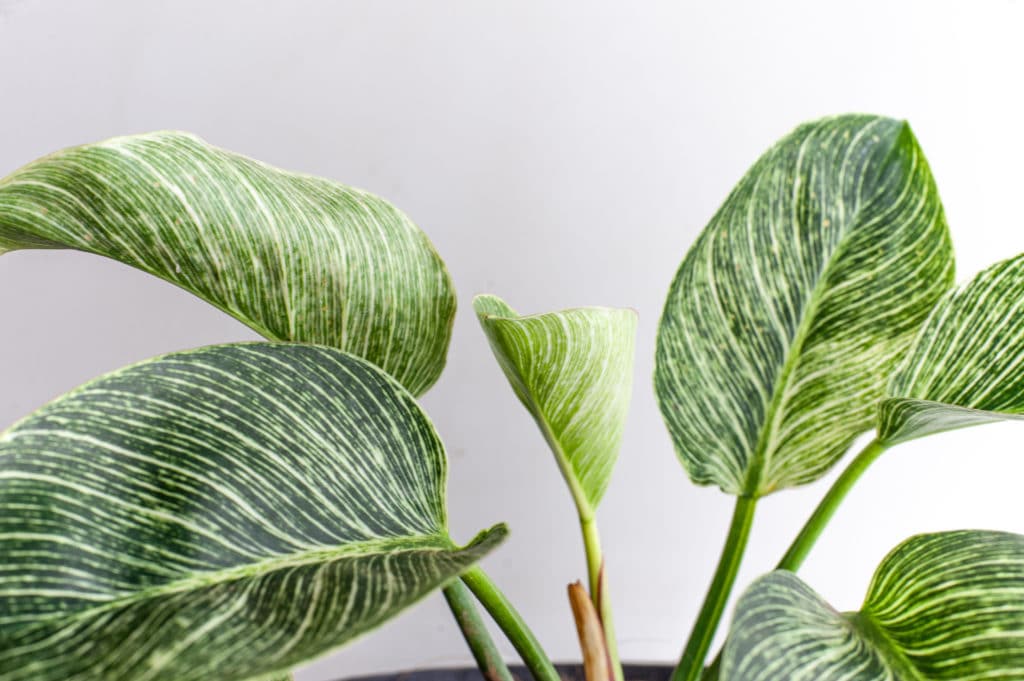
The Philodendron Birkin is a new, beautiful philodendron hybrid variety that makes the perfect houseplant. They are compact, slow-growing, and relatively easy to care for.
If you haven’t heard of them yet (you’re not alone!), these Birkins are identified by their round leaves with mildly pointed tips and vivid white pinstripes.
Origin of the Philodendron Birkin
Philodendrons originated in Brazil’s rainforests in the 1600s. Philodendron comes from the Greek word philodendron, which means “tree lover.” Philodendrons are a genus of 489 species that live in subtropical and humid regions.
Azalias, most frequently known for their huge, lovely leaves, can be climbing plants but are commonly cultivated as houseplants. They’ve recently been featured in the Costa Farms 2021 Trending Tropicals collection, especially recently since they were part of it.
Birkin Leaves
Birkin leaves are identified by their round, deep green leaves with mildly pointed tips and vivid white pinstripes and variegation. No two leaves are the same – thanks to the plump, thick stems they’re always prominently on display.
Caring For Your Birkin
Philodendrons in general are considered low-maintenance plants that can be left alone for long periods of time without any major problems arising.
However, as with all plants, there are some things you can do to ensure your Birkin thrives in its environment.
– Philodendrons prefer indirect light, so make sure to place them in an area where they will receive plenty of natural light but won’t be exposed to direct sunlight.
– When watering, give your plant a good soaking and then wait until the top few inches of soil are dry before watering again.
– Philodendrons like moist soil but don’t want to sit in water, so make sure to use a drainage dish or tray if you’re not going to water your plant directly from the pot it’s in.
Philodendron Birkin Care
Birkin philodendrons are a new, beautiful hybrid variety that make the perfect houseplant.
They are compact, slow-growing, and relatively easy to care for.
They come from a cross between a Philodendron selloum and Philodendron cordatum. Birkin leaves are identified by their round, deep green leaves with mildly pointed tips and vivid white pinstripes.
When watering, give your plant a good soaking then wait until the top few inches of soil are dry before watering again.
Philodendrons prefer indirect light so make sure to place them where they will receive plenty of natural light but not be exposed to direct sunlight. The result is a plant that is compact, slow-growing, and relatively easy to care for.
All Birkins now are grown using tissue culture, rather than clonal propagation. Birkins can revert into Rojo Congo or even mutate again, depending on the conditions.
Despite their green leaves with white stripes, Birkin leaves have been observed to develop crimson and cream-colored foliage.
Philodendron Birkin growth
The fact that Birkins take so long to grow makes them perfect house plants. You may choose a lovely container and, chances are, you’ll never have to repot it.
At the absolute minimum, you can expect your pot to last at least five years. Weeping Angel Plant is not suited for full sunlight or high humidity conditions because of its sensitivity to direct light and high humidity environments.
Philodendron Birkin is a tropical plant, which means it needs to be kept warm and humid. It can grow under fluorescent lights or incandescent light bulbs as long as they are fairly close to the leaves of the plant so that it will receive sufficient lighting.
Philodendron Birkin size
The Philodendron Birkin is one of those plants with unique characteristics. The newest member of this family comes in shades of green, white, reds – even blues!
This form has variegated leaves that show off its different colors more than most other varieties do theirs. Its leaf blades come together at an acute angle just above the stem’s base forming what looks like two “shoulders” per side paired with another at the top.
The Birkin’s leaves are generally about six to eight inches long, making it a great choice for those with limited space or who want an attractive plant that doesn’t grow too tall.
No two leaves are ever identical on this stunning philodendron hybrid variety – thanks to the plump, thick, bright stems, they’re always prominently on display.
Birkins are identified by their round, deep green leaves with mildly pointed tips and vivid white pinstripes and variegation.
What kind of light is best for the Birkin?
Philodendron Birkin is a tropical plant, which means it needs to be kept warm and humid. It can grow under fluorescent lights or incandescent light bulbs as long as they are fairly close to the leaves of the plant so that it will receive sufficient lighting.
How much water does a Philodendron Birkin need?
Keeping your Philodendron Birkin hydrated is one of the most important aspects of its upkeep. They like to be kept moist, but not wet. A good way to tell if your plant needs water is to check the soil. If the top inch of soil is dry, it’s time for a drink.
Birkin pot
The Philodendron Birkin grows slowly, so you might not have to repot it for many years – or ever.
You may choose a lovely container and, chances are, you’ll never have to repot it. At the absolute minimum, you can expect your pot to last at least five years.
Birkin Soil
The Birkin plant prefers a loose, well-draining potting soil. A potting mix that is heavy in organic matter will work well. You can also make your own soil mixture by combining one part peat moss to one part sand.
Birkin fertilizer
Philodendron plants require only minimal care and do not need to be fertilized very often.
The best way to feed your houseplant is by watering it with liquid fertilizer once every two weeks during the spring and summer months when the Philodendron is actively growing new leaves.
Weeping Angel Plant isn’t particularly hungry for nutrients, but should still get an occasional boost of NPK from time to time in order to stimulate healthy growth.
In early fall or late winter, stop feeding cold weather sensitive Philodendrons like these guys because they’ll go into hibernation mode otherwise.
Avoid using any type of lime-based fertilizer, as this can harm the Birkin plant.
Birkin light
Philodendron Birkin is a tropical plant, which means it needs to be kept warm and humid. It can grow under fluorescent lights or incandescent light bulbs as long as they are fairly close to the leaves of the plant so that it will receive sufficient lighting.
What pests attack Philodendron Birkin?
Philodendrons are generally free of insect problems if grown in the right conditions. If your plant is kept outside or near a window that gets lots of sunshine, then you may need to watch out for spider mites due to excessive dryness caused by sunlight exposure – they’re not pretty!
Spider mites love houseplants and will suck juices from leaves causing them to turn color before eventually killing them off entirely.
You’ll know there’s a problem when webs begin appearing between leaf veins or on top of leaves… you might even see some bugs hanging around too.
A horticultural oil or insecticidal soap can help get rid of spider mites, but it’s best to prevent them from getting a foothold in the first place by keeping your plant healthy and well-watered.
Birkin leaves
No two Philodendron Birkin leaves are alike!
The leaves are identified by their round, deep green with mildly pointed tips and vivid white pinstripes and variegation. They grow plump, thick, and bright stems that are always prominently on display.
